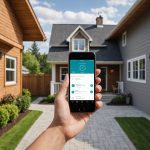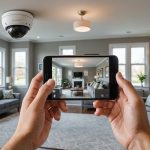Your Ultimate Guide to Installing a Smart Home Surveillance System with Your Smartphone
In today’s world, ensuring the security of your home is more crucial than ever. With the advancement of technology, installing a smart home surveillance system has become easier and more accessible. Here’s a comprehensive guide to help you set up and manage your home security cameras using your smartphone.
Choosing the Right Security Cameras for Your Home
When it comes to selecting the best security cameras for your home, several factors need to be considered. Here are some key points to keep in mind:
Topic to read : Enhancing Smartwatch Fitness Tracking: Innovative Techniques for Better Accuracy
Types of Cameras
- Indoor Cameras: Ideal for monitoring main rooms and hallways. Look for cameras with high-resolution video, night vision, and motion detection. For example, the Arlo Pro 5 is highly regarded for its compact design, easy installation, and excellent video quality[3].
- Outdoor Cameras: These need to be weather-resistant and have a wide viewing angle. The Inocam Dome v2, with its IP66 rating, can withstand rain and other outdoor conditions, and it features a 3MP camera with infrared night vision[1].
Key Features
- Resolution and Field of View: A higher resolution (e.g., 1080p or 3MP) ensures clearer images. A wider field of view helps cover more area with fewer cameras.
- Night Vision: Infrared or night vision capabilities are essential for monitoring your home at night.
- Motion Detection: This feature alerts you to any movement, reducing unnecessary notifications.
- Two-Way Audio: Allows you to communicate with visitors or intruders through the camera.
- Cloud Storage: Consider cameras that offer cloud storage options or local storage via SD cards to keep your videos safe[2][5].
Installation and Setup of Your Security Cameras
Installing your security cameras is relatively straightforward, especially with the help of dedicated mobile apps.
Step-by-Step Installation Guide
- Physical Installation:
- Place cameras in strategic locations such as near entry points (doors, windows) for outdoor cameras, and in main rooms and hallways for indoor cameras[2].
- Ensure the camera is securely fastened to prevent tampering or theft.
- Powering the Camera:
- Connect the camera to a power source using the provided adapter and connector[1].
- Connecting to Your Network:
- Use the mobile app (e.g., Tuya Smart, Tike Sécurité) to connect the camera to your Wi-Fi network. Many apps generate a QR code that simplifies this process[1][2].
- Configuring the App:
- Download and install the app on your smartphone.
- Follow the in-app instructions to add the camera to your account.
- Configure settings such as motion detection, alert notifications, and video storage options.
Integrating Your Cameras with Your Smart Home System
Integrating your security cameras with your smart home system can enhance your home’s security and convenience.
Also to see : Mastering Your Smartphone: A Complete Guide to Installing a Smart Home Security System
Compatibility with Smart Home Devices
- Voice Assistants: Many security cameras are compatible with Amazon Alexa and Google Assistant, allowing you to control and monitor your cameras with voice commands[4].
- Smart Home Hubs: Cameras can be integrated with smart home hubs to create a centralized security system. For example, IMA PROTECT offers a comprehensive system that includes camera monitoring, alarm systems, and energy management[4].
Example Integration
- Tike Sécurité: This system allows you to manage all your security devices, including cameras, alarms, and detectors, through a single mobile app. You can receive real-time alerts, monitor live footage, and adjust settings remotely[2].
Monitoring and Managing Your Security Cameras
Effective monitoring and management of your security cameras are crucial for maximizing their benefits.
Real-Time Monitoring
- Use your smartphone app to monitor live footage from your cameras. This is particularly useful when you are away from home and want to check on your property[2][5].
Customizing Notifications
- Adjust notification settings to avoid false alarms. You can set specific zones and times for motion detection alerts to ensure you only receive notifications when necessary[2].
Video Storage and Retrieval
- Choose between cloud storage and local storage options. Cloud storage provides off-site security for your videos, while local storage via SD cards offers more control over your data[3][5].
Table: Comparing Popular Smart Home Security Cameras
| Camera Model | Resolution | Night Vision | Motion Detection | Two-Way Audio | Cloud Storage | Price Range |
|---|---|---|---|---|---|---|
| Inocam Dome v2 | 3MP | Yes (Infrared) | Yes | Yes | Yes | €100-€200 |
| Arlo Pro 5 | 1080p | Yes (Infrared) | Yes | Yes | Yes (Optional) | €150-€300 |
| TP-Link Tapo C420 | 1080p | Yes (Infrared) | Yes | Yes | Yes (Optional) | €200-€300 |
| Netatmo Extérieure | 1080p | Yes (Infrared) | Yes | Yes | Yes (Local SD) | €150-€250 |
Practical Tips and Considerations
Here are some practical tips to keep in mind when setting up and using your smart home surveillance system:
Placement Tips
- Strategic Placement: Place cameras where they can capture clear views of entry points and vulnerable areas. For outdoor cameras, ensure they are out of reach to prevent tampering[2].
- Power Source: Ensure that the power source for your cameras is secure and not easily accessible to intruders.
Legal Considerations
- Privacy Laws: Be aware of local laws regarding video surveillance. In France, for example, there are specific regulations governing the use of security cameras[3].
Maintenance and Troubleshooting
- Regular Updates: Keep your camera software and app updated to ensure you have the latest security patches and features.
- Battery Life: For battery-powered cameras, monitor the battery life and replace batteries as needed to avoid downtime.
Quotes from Experts and Users
- “The integration of security cameras with our smart home system has been a game-changer. We can now monitor our home from anywhere and receive instant alerts if something suspicious happens,” says Sarah, a satisfied user of Tike Sécurité.
- “When choosing a security camera, it’s crucial to consider the resolution, night vision, and motion detection capabilities. These features ensure that you get clear and relevant footage,” advises John, a security expert.
Installing a smart home surveillance system with your smartphone is a straightforward and effective way to enhance your home’s security. By choosing the right cameras, integrating them with your smart home system, and managing them effectively, you can enjoy peace of mind knowing your property is well-protected.
Remember, the key to a successful installation is careful planning, strategic placement, and regular maintenance. With the right tools and knowledge, you can create a robust security system that keeps your home safe and secure.











